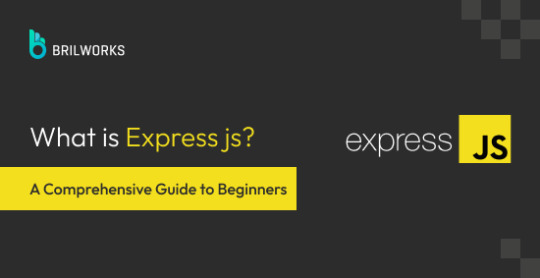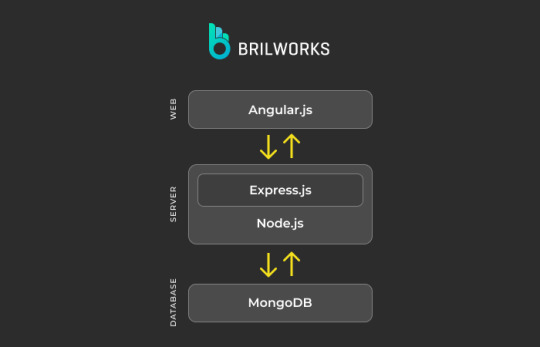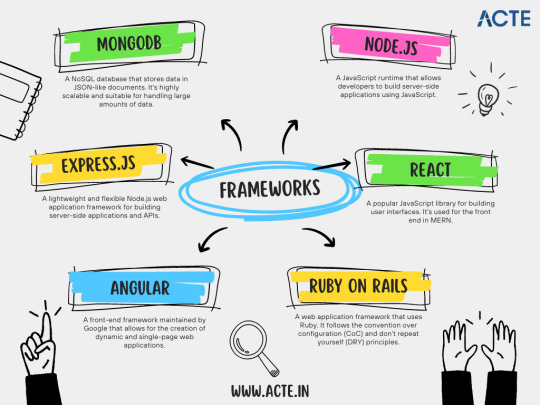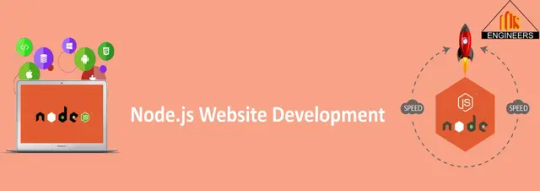#nodejs framework
Explore tagged Tumblr posts
Text
Node.js has quickly become the technology of choice for building extremely scalable, high-performance web applications, APIs, and real-time services. In the current fight among companies to create cutting-edge applications, most firms are outsourcing Node.js development in order to cut on costs, utilize specialized skills, and compress their development cycles. Outsourcing of Node.js development can give your business flexibility, expertise, and scalability needed to bring those projects to life. Whether running real-time applications, scaling web services, or developing enterprise-level platforms, outsourcing Node.js development is a strategic choice that helps gain access to the best talent and control cost.
0 notes
Text
What is Express.js? A Comprehensive Guide to Beginners

Let’s start with web development.
When we talk about web development, we are basically essentially talking about the front-end and back-end (also referred to as server-side). Express is a backend development Nodejs framework.
What is a Nodejs Framework?
This section is for those who are not familiar with frameworks. If you already know what a framework is, please feel free to skip ahead.
Writing an application from scratch is time-consuming and tedious, especially in today’s fast-paced world, and initial setup may involve a lot of boilerplate code, such as setting up ports and defining route handlers; frameworks help to save time and effort by providing a pre-built set of tools and libraries that can be used to quickly and easily create a web application. This can free up developers to focus on the things that matter most — writing logic and advanced functionalities.
What is Express js?

The image shows how a tech stack contributes to complete web development. For instance, when it comes to data storage, a Database (e.g., MongoDB) is required, and for writing the front end, various frameworks exist today, such as Angular.js.(in MEAN stack).
Similarly, you need to use a backend-specific language or framework for the backend. Some popular backend languages include Python, Java, JavaScript (Node.js), and PHP, while Django, Express.js, and Flask are some of the popular backend frameworks.
If you want to use JavaScript in the backend, you typically need to use the Node.js runtime environment. Node.js allows you to run JavaScript code outside of a web browser, which makes it possible to use JavaScript for both the front end and back end of a web application.
On top of Nodejs, several frameworks have been created, among which is Express. More precisely, it is a layer built around Node.js that significantly simplifies the process of working within the Node.js environment and reduces development complexity.
Express is an open-source web application framework for Node.js. It provides a robust set of features for building web and mobile applications, including routing, middleware, template engines, seamless database integration, and a wealth of features for developing advanced features and functions.
Note: In this article, when we refer to web applications with Express, we are explicitly referring to the development of “back-end services or APIs.”
Features of Express
1. An array of pre-built tools
The framework includes an array of tools for web applications, routing, and middleware for building and deploying large-scale, enterprise-ready applications.
2. Node package manager
It comes up with a Node package manager and a command-line interface(CLI), allowing you to create project structures, generate routes, controllers, and other components, as well as manage dependencies and configuration settings.
3. Middleware
Middleware in Express is used as snippets of code that intercept requests and responses, manage errors, and perform various other tasks, helping you to perform actions like validation, logging, and authentication in a reusable and modular way.
4. Routing
ExpressJS offers developers a straightforward routing system that simplifies the handling of HTTP requests. In addition, it allows you to define your own special paths and rules for these requests.
Applications of Expressjs
It is termed as a versatile framework that developers employ for constructing APIs, single page and real-time applications, microservices, proxy servers, CMSs, backend for mobile applications, authentication, authorization mechanisms, and many more services. Below is a list of the application you can build using Express js.
1. APIs for Single Page Application
Single-page applications (SPAs) are a popular type of web application that loads all of the content for the page in one go. This means that the user does not have to wait for the page to reload when they interact with it, which can provide a smoother and more responsive experience.
Some popular examples of SPAs include Gmail, Google Maps, and Spotify. These apps are able to provide a great user experience because they only need to load the content once, and then they can dynamically update the content based on the user’s actions. This makes for a very fluid and interactive experience. Express is used for developing back-end services, or APIs, for single-page applications to fetch data.
2. Real-time applications
Real-time applications are increasingly popular as they allow users to interact with each other in real time. Some popular examples of real-time applications include multiplayer games, chat apps, and collaboration tools. Express is used in developing real-time applications.
It helps you build the basic structure, like handling web pages and buttons, and when you want your website to instantly update without needing to refresh the page, Express.js and socket.io can work together.
Express.js can take care of the regular stuff your website needs, like showing pages and handling regular requests. While WebSockets enables real-time data exchange between the server and clients.
3. Streaming applications
Streaming applications are becoming increasingly popular as they allow users to watch movies, TV shows, and other content on demand. Some popular examples of streaming applications include Netflix, Hulu, and Disney+.
You can leverage Express in streaming applications for a variety of tasks, including handling requests, serving media files, developing authentication and authorization modules, implementing search and recommendations, and many more functionalities.
4. Fintech application
Some popular fintech applications that are built with Express.js include Robinhood, Coinbase, and PayPal. Leveraging the robust functionalities of Express.js, these applications efficiently manage intricate financial transactions.
5. APIs
APIs are software intermediaries that allow different systems to communicate with each other. They are widely utilized by different systems for integrating payment gateways, social media integrations, and e-commerce integrations. Brillworks has developed a suite of APIs and applications for the business consulting and media preservation industries, which includes critical functions such as company setup, visa services, corporate services, file management, customer portal, CMS portal, bulk upload, etc.
Read more: https://www.brilworks.com/blog/what-is-express-js-comprehensive-guide-to-beginners/
0 notes
Text
NodeJS excels in web development with its event-driven, non-blocking I/O model, making it ideal for handling concurrent connections and real-time applications like chat apps and live streaming. Its single-threaded architecture and use of JavaScript, both on the server and client side, allow for seamless development across the entire stack. NodeJS is especially suitable for startups and projects that require fast, scalable, and high-performance solutions.
Java, on the other hand, is renowned for its robustness, security, and platform independence. It is a mature technology with a vast ecosystem and a wealth of libraries and frameworks, such as Spring and Hibernate, which facilitate the development of large-scale, enterprise-grade applications. Java's multithreading capabilities and strong memory management make it well-suited for complex, resource-intensive applications where stability and reliability are paramount.
Choosing between NodeJS and Java ultimately depends on the specific needs of your project. For real-time, scalable applications with a need for rapid development, NodeJS is a compelling choice. For enterprise-level applications requiring high stability, security, and comprehensive tool support, Java is often the preferred technology.
#nodejs#javascript#web development#framework#best web development company in usa#software#node js development company#javaprogramming#programming
3 notes
·
View notes
Text
Becoming a Full Stack Developer: My Roadmap to Mastery
Embarking on my journey to become a full stack developer has been nothing short of a thrilling adventure. It's been filled with moments of incredible learning, personal growth, and a profound passion for creating digital solutions that truly make a difference. From the fascinating world of front-end design to the intricate workings of back-end development, let me take you through my personal roadmap to mastering the art of full stack development.

Defining Full Stack Development
At its core, I see a full stack developer as a tech-savvy magician who possesses the unique ability to bring both the user-facing magic of the front end and the powerful machinery of the backend to life. It's not merely about coding; it's about the art of crafting seamless user experiences while skillfully managing the complex infrastructure that makes it all possible.
Self-Assessment
Like any journey, mine began with self-awareness. I took a close look at my existing skills and knowledge. I uncovered my strengths to build upon and identified the areas where I needed improvement. This self-assessment became the bedrock upon which I constructed my roadmap, allowing me to set clear, focused goals for my full stack development journey.
Front-End Development Skills
Mastering front-end technologies proved to be a thrilling challenge. Moving from the foundational HTML and CSS, which provide structure and style to web pages, to delving into the captivating realm of JavaScript with its dynamic interactions, each step forward brought its own set of revelations and challenges. My journey was marked by moments of both frustration and triumph as I evolved from crafting basic layouts to creating intricate user interfaces that sprung to life at the simple click of a button.
Back-End Development Skills
Transitioning to the backend was like stepping into a whole new world of data management, server intricacies, and complex logic. Learning languages like Python, diving deep into databases like MySQL, and exploring frameworks such as Flask and Django became the building blocks of my backend journey. The sheer satisfaction of watching my code efficiently manage data and orchestrate complex operations fueled my determination to keep pushing forward.
Bridging the Gap
The leap from front-end to back-end wasn't a smooth one. Bridging this gap required not only the acquisition of new technical skills but also a shift in mindset. The challenges were numerous – learning to handle data securely, optimizing performance, and orchestrating intricate processes. I adopted various strategies to make this transition seamless, eventually allowing me to unite my front-end and back-end skills into a unified full stack approach.
Full Stack Development Frameworks
The full stack development world introduced me to a plethora of frameworks designed to streamline the entire process. Frameworks like MEAN (MongoDB, Express.js, Angular, Node.js) and MERN (MongoDB, Express.js, React, Node.js) became my trusted companions. They not only accelerated development but also offered valuable insights into the best practices of full stack architecture.

Building Projects
Knowledge truly gains momentum when it's put into practice. Building projects became an essential part of my journey. These projects provided the practical experience necessary to solidify my skills. Whether it was crafting dynamic e-commerce platforms or developing interactive web applications, each project served as a canvas for innovation, experimentation, and continuous improvement.
Continuous Learning
Full stack development is an ongoing journey without a defined finish line. The ever-evolving landscape continually demands learning and adaptation. To stay updated with emerging trends and technologies, I relied on online platforms, coding communities, and valuable resources like full stack developer course and blogs provided by ACTE.

Challenges and Rewards
This journey had its fair share of difficulties, of course. Debugging cryptic errors, optimizing code for performance, and keeping pace with rapid technological advancements were just a few of the hurdles I encountered. However, the rewards far surpassed the struggles. The ability to transform ideas into functional applications, the satisfaction of solving intricate puzzles, and the sheer joy of witnessing my work in action were the driving forces that kept me moving forward.
Networking and Community
In today's digitally connected world, networking is an invaluable asset. Engaging with developer communities and attending meetups opened doors to fresh perspectives, exciting collaborations, and invaluable insights. The support and camaraderie of fellow developers served as a constant reminder that I wasn't alone on this journey.
Becoming a full stack developer is about more than just acquiring technical skills; it's a transformative journey of self-discovery, overcoming challenges, and embracing growth. To all those aspiring full stack developers out there, my advice is to wholeheartedly embrace each challenge as a learning opportunity. Your roadmap may take unexpected turns, but with dedication, resilience, and a deep passion for innovation, you too can navigate the path to mastery. The world of full stack development awaits – so go forth and code boldly!
6 notes
·
View notes
Text
Node.Js Development Company in New York
LDS Engineers stands out as a premier Node.Js Development Company in New York, USA, when it involves top Node.Js development services offerings; We concentrate on handing over first-rate, scalable, and robust Node.Js answers to clients across the globe, which includes America, the UK, Australia, and India. Our group of professional developers is well-versed in creating effective internet applications that cater to various commercial enterprise wishes.

Why Choose LDS Engineers for Node.Js Development?
At LDS Engineers, we believe in delivering progressive, efficient, and reliable Nodejs development solutions. Our developers are highly skilled and dedicated to providing first-rate backend development for agencies of all sizes. Whether you need a small business website or a complex enterprise-level application, we ensure that our solutions align with your goals and business necessities.
Our Node.Js Development Services
We provide an extensive range of Node.Js development offerings, together with:
Custom Node.Js Web Development: We construct tailor-made internet programs to fulfill your specific commercial enterprise wishes.
Node.Js API Development: Our crew develops sturdy and steady APIs for seamless machine integration.
Node.Js App Development: We create excessive-performance packages with a consumer-pleasant interface.
Real-time Application Development: We specialize in building actual-time apps, together with chat packages and stay-streaming solutions.
Node.Js Plugin Development: Our developers create plugins to beautify the functionality of your application.
E-commerce Solutions: We expand scalable and steady e-trade platforms with the usage of Node.Js.
Node.Js Consulting Services: Our expert specialists assist groups that leverage Node.Js for the most excellent overall performance.
Our Development Process
LDS Engineers follows an established and consumer-centric method for Node.Js development:
Requirement Analysis: We start by way of knowledge of your undertaking requirements and business goals.
Designing Phase: Our designers create visually stunning and consumer-friendly interfaces.
Development: Our builders deliver the layout to life with the usage of modern-day Node.Js technology.
Testing: We behave rigorously in trying to ensure a computer virus-unfastened and seamless experience.
Deployment & Support: We launch your project and provide continuous support to maintain its performance.
Benefits of Working with LDS Engineers
Expert Team: Our developers are exceptionally professional and experienced in Node.Js development.
Cost-effective Solutions: We offer affordable but outstanding development services.
Timely Delivery: We adhere to strict timelines to mensureon-time mission delivery.
Flexible Engagement Models: Choose from distinct engagement models based on your undertaking wishes.
Customer Satisfaction: Our primary aim is to exceed client expectations with our answers.
Partner with Us for the Best Node.Js Solutions
If you're looking for a reliable and efficient Node.Js website development services in New York, LDS Engineers is your exceptional desire. We increase present-day applications that assist companies thrive inside the virtual landscape. Our commitment to excellence, innovation, and patron satisfaction makes us the favored choice for customers worldwide.
Connect with LDS Engineers today and take your commercial enterprise to new heights with our pinnacle-notch Node.Js development offerings!
node.js website development, node.js development services, node.js app development, node.js website development solutions, node.js development, nodejs development solutions, node.js framework development, node.js development company.
#node.js website development#node.js development services#node.js app development#node.js website development solutions#node.js development#nodejs development solutions#node.js framework development#node.js development company#tumblr#like#follow#photography#art#quotes#likeforlikes#explore#explorepage#likes#tumblrpost
0 notes
Text
#nodejs development#nodejs developers#hire node js developers#mobile app development#Web development#nodejs frameworks#nodejs mobile app development
0 notes
Text
2024's Top Backend Frameworks: What You Need to Know
Discover the top Backend Frameworks of 2024, designed for maximum performance and scalability." Stay ahead of the competition with innovative tools designed to match the demands of today's technology landscapes.

0 notes
Text
youtube
0 notes
Text
#list of nodejs frameworks#top 10 nodejs frameworks#nodejs web development company#top nodejs development company#best nodejs development agency#hire nearshore nodejs developers
0 notes
Text
Laravel Vs Node Js: Which one is better?

Confused about Laravel vs Node JS? This guide explores their strengths, use cases, and helps you pick the right technology for your project.
#laravel#nodejs#node#laravel framework#laravel developers#laravel development services#nodejs development
1 note
·
View note
Text
#dapl#digital aptech#node.js development#nodejs developers#nodejs development#node.js#nodejs#framework
0 notes
Text
As many of us are aware, selecting a programming language for the creation of applications may be very difficult. There isn't a better solution than Node.js if you find yourself in a similar circumstance and want to invest in application development. Since 2009, Node.js has been in development. It has grown to be one of the most widely used programming languages nowadays for creating sophisticated apps quickly. You may be considering how you might invest in your application development while taking advantage of the latest developments in Node.js in 2024. If you have doubts and want to know more about this then go through this article.
0 notes
Text
Building Scalable Microservices With Node.Js: Frameworks And Feature

In today’s rapidly evolving technological landscape, building scalable and efficient applications has become a necessity. One of the ways to achieve these objectives is by adopting a microservices architecture. As developers, we are always on the lookout for powerful tools and frameworks that simplify the process of developing and maintaining microservices. One such option for building microservices is using a Nodejs microservice framework.
What is Nodejs Microservice Framework? Nodejs Microservice Framework is a tool or a platform that allows developers to build and deploy microservices using Node.js. Microservices are small, independent services that work together to create a larger application. Instead of building a monolithic application, where all functionalities are tightly coupled, microservices allow developers to break down the application into smaller, manageable pieces.
A Node.js Microservice Framework provides the necessary infrastructure and utilities to build, deploy, and manage these microservices. It offers a set of libraries, frameworks, and tools that facilitate the development process and make it more efficient. The framework handles the common tasks associated with microservices, such as service discovery, load balancing, fault tolerance, and inter-service communication. This allows developers to focus on writing business logic instead of dealing with the intricacies of microservices architecture.
Why should you consider using a Node.js Microservice Framework? There are several benefits of using a Node.js Microservice Framework for building your microservices architecture. Firstly, Node.js itself is known for its non-blocking, event-driven architecture, which makes it ideal for handling a large number of asynchronous requests. This allows your microservices to scale and handle high traffic loads efficiently. Node.js Microservice Frameworks leverage this strength of Node.js and provide additional features and tools to make the development process smoother.
Secondly, a Node.js Microservice Framework provides a modular and scalable architecture for your application. As each microservice performs a specific function, you can develop, test, and deploy them independently. This means that you can update or replace a particular microservice without impacting the rest of the application. This flexibility allows for faster development and deployment cycles, making it easier to adapt to changing business needs.
Thirdly, a Node.js Microservice Framework simplifies the management and coordination of microservices. It provides features like service discovery, load balancing, and fault tolerance out-of-the-box, reducing the effort required to handle these aspects manually. Additionally, most frameworks offer monitoring and logging tools that allow you to track the performance and health of your microservices.
Features of a Node.js Microservice Framework A Node.js Microservice Framework typically includes the following features:
Service discovery: The framework provides a way to register and discover microservices, allowing them to communicate with each other.
Load balancing: It distributes the incoming requests across multiple instances of a microservice to ensure even workload distribution.
Inter-service communication: The framework offers mechanisms for microservices to communicate with each other, such as HTTP, messaging queues, or event-based systems.
Fault tolerance: It handles failure scenarios, such as service unavailability or slow response, and provides mechanisms like retries or circuit breaking to ensure system reliability.
Monitoring and logging: The framework provides tools to monitor the performance and health of microservices and logs events and errors for debugging purposes.
These features help developers manage and orchestrate their microservices efficiently and enable them to build reliable and scalable applications.
Benefits of using a Node.js Microservice Framework When it comes to building scalable and high-performance applications, Node.js has become a popular choice among developers. By leveraging its event-driven, non-blocking I/O model, developers can create highly efficient and responsive applications. When combined with a microservice architecture, Node.js becomes even more powerful.
A Nodejs microservice framework provides a set of tools and libraries that help developers build, deploy, and manage microservices. It abstracts away the complexities of building a distributed system, allowing developers to focus on writing business logic rather than dealing with infrastructure concerns.
1. Scalability One of the key benefits of using a Node.js microservice framework is its scalability. Node.js is well-known for its ability to handle a large number of concurrent connections with minimal resources. By breaking down an application into microservices, each service can scale independently based on its specific demands. This allows the system to handle high traffic loads more efficiently.
2. Flexibility Nodejs microservice frameworks offer flexibility in terms of design and implementation choices. Developers have the freedom to choose the best-suited architecture for their application, be it a monolithic architecture or an event-driven architecture. The modular nature of microservices allows for easy integration with other systems, enabling developers to experiment and iterate quickly.
3. Fault isolation In a microservice architecture, each microservice runs as a separate process or container. If one microservice encounters a failure or a performance issue, it will not affect the other services. This fault isolation improves the overall resilience and availability of the system. Additionally, it allows developers to update or replace individual microservices without disrupting the entire application.
4. Team collaboration Microservices enable teams to work independently on different parts of the application. Each team can focus on a specific microservice, allowing for faster development cycles. Since microservices are decoupled from each other, teams can choose different technologies and frameworks based on their expertise, without affecting the whole system.
5. Ease of deployment and scalability A Node.js microservice framework simplifies the deployment and scalability process. Each microservice can be deployed independently, allowing for continuous deployment and seamless updates. The framework often provides built-in tools for monitoring and scaling the services, making it easier to manage and scale the infrastructure as the application grows.
6. Improved fault tolerance All microservices in a Node.js microservice architecture can be designed to be fault-tolerant. By ensuring that each microservice can handle failures and gracefully recover, the overall system becomes more resilient. The framework may provide features like load balancing, service discovery, and circuit breakers to improve fault tolerance and prevent cascading failures.
Overall, using a Node.js microservice framework brings numerous benefits in terms of scalability, flexibility, fault isolation, team collaboration, ease of deployment, and fault tolerance. It provides developers with the tools and abstractions needed to build highly scalable and maintainable microservices-based applications.
Features of a Node.js Microservice Framework A Node.js microservice framework comes with a wide range of features that make it a powerful tool for building and managing microservices. Here are some key features to look for:
Lightweight and Scalable: One of the main advantages of using a Node.js microservice framework is its lightweight and scalable nature. Node.js itself is designed to be efficient and lightweight, making it ideal for building microservices that can handle large amounts of traffic and scale easily.
Modular Architecture: A good Node.js microservice framework allows you to build your microservices in a modular way. This means you can break down your application into smaller, reusable components called modules, which can be developed and tested independently. This modular architecture makes it easier to maintain and update your microservices.
API Gateway: An API gateway is a key component in microservice architecture. It acts as a single entry point for all client requests and forwards them to the appropriate microservice. A Node.js microservice framework should provide an API gateway that can handle routing, load balancing, and other tasks required for managing the flow of requests between microservices.
Service Discovery: Another important feature of a Node.js microservice framework is service discovery. In a microservice architecture, services may come and go dynamically. A service discovery mechanism allows microservices to find and communicate with each other without having to hardcode any dependencies. This makes it easier to add or remove microservices without disrupting the overall system.
Monitoring and Logging: Monitoring and logging are crucial for understanding the health and performance of your microservices. A good Node.js microservice framework should provide tools for monitoring and logging important metrics, such as response times, error rates, and resource usage. This helps you identify and troubleshoot issues quickly.
Error Handling and Resilience: Fault tolerance and resilience are critical in microservice architecture. A Node.js microservice framework should have built-in mechanisms for handling and recovering from errors, such as circuit breakers, retries, and fallback strategies. These features ensure that your microservices can handle failures gracefully and continue to function effectively.
These are just a few of the key features you should look for in a Node.js microservice framework. Each framework may have its own unique set of features, so it’s important to evaluate your specific needs and choose a framework that meets them effectively.
Nodejs Microservice Frameworks: Examples If you are considering building a microservice architecture with Node.js, you are in luck! There are several popular Node.js microservice frameworks available that can simplify the development process and help you create robust and scalable applications. Here are some examples:
1. Express.js Express.js is one of the most widely used and popular Node.js frameworks for building web applications and APIs. It provides a simple and minimalistic approach to building microservices with its middleware and routing capabilities. Express.js is known for its flexibility and ease of use, making it a popular choice among developers.
2. Nest.js Nest.js is a progressive Node.js framework that is gaining popularity for building efficient and scalable server-side applications. It is built on top of Express.js and provides a modular and structured approach to developing microservices. Nest.js follows the architectural principles of Angular, making it easy to understand and maintain.
3. Fastify Fastify is a lightning-fast web framework for Node.js that focuses on speed and performance. It is designed to handle a high volume of requests and provides a powerful plugin system for adding functionality to your microservices. Fastify also offers built-in support for TypeScript, making it a great choice for developers who prefer static typing.
4. Hapi Hapi is a mature and robust Node.js framework that excels in building microservices and APIs. It provides a rich set of features and plugins, making it highly customizable and adaptable to your specific project requirements. Hapi is known for its emphasis on configuration over convention, giving developers the freedom to build microservices the way they want.
5. Seneca Seneca is a microservices framework for Node.js that focuses on the concept of pattern matching. It provides a decentralized and scalable approach to building microservices by enabling communication between services using message passing. Seneca is well-suited for complex and distributed systems and offers a wide range of plugins for adding functionality.
6. Moleculer Moleculer is a fast and scalable microservices framework for Node.js that aims to simplify the development of distributed systems. It provides a powerful service registry, load balancing, and fault-tolerant mechanisms out of the box. Moleculer also supports multiple transporters, such as TCP, Redis, NATS, and MQTT, making it highly flexible and adaptable.
7. Micro Micro is a lightweight microservices framework for Node.js that focuses on simplicity and minimalism. It provides a small and composable core, allowing developers to pick and choose the features they need. Micro is ideal for building small and isolated microservices that can be easily deployed and scaled independently.
8. Adonis.js Adonis.js is a full-featured web framework for Node.js that provides a robust set of tools and conventions for building microservices and APIs. It follows the MVC (Model-View-Controller) architectural pattern and offers features like authentication, database ORM, and WebSocket support out of the box. Adonis.js is a great choice for developers looking for a complete and opinionated framework.
9. Koa.js Koa.js is a lightweight and expressive web framework for Node.js that focuses on simplicity and modularity. It provides an elegant middleware system, allowing developers to create reusable and composable components for building microservices. Koa.js is known for its clean and intuitive API, making it easy to write maintainable and readable code.
10. Restify Restify is a specialized web framework for building RESTful APIs with Node.js. It is designed to be lightweight and efficient, providing a streamlined set of features specifically tailored for building microservices. Restify offers built-in support for features like versioning, content negotiation, and request/response validation, making it a popular choice for API development.
These are just a few examples of the many Node.js microservice frameworks available. Each framework has its own unique features and strengths, so it’s important to choose the one that best fits your project requirements and development preferences. Regardless of which framework you choose, building microservices with Node.js can greatly enhance the scalability, maintainability, and performance of your applications.
Conclusion In conclusion, Node.js microservice frameworks provide developers with a powerful and efficient way to build scalable and modular applications. With their lightweight and event-driven architecture, they are well-suited for handling the demands of modern web development.
By using a Node.js microservice framework, developers can take advantage of several benefits, including improved performance, increased productivity, and easier maintenance of the application. These frameworks also provide a wide range of features such as built-in support for service discovery, load balancing, and fault tolerance, making it easier to develop and deploy microservices.
There are several popular Nodejs microservice frameworks available, each with its own unique features and capabilities. By choosing the right framework for your project, you can leverage its strengths to build scalable and robust applications.
Overall, Nodejs microservice frameworks offer a flexible and efficient way to develop, deploy, and manage microservices in a distributed architecture. With their lightweight and modular nature, they provide developers with the tools they need to build complex applications with ease.
So, whether you are a seasoned developer or just starting with microservices, consider using a Nodejs microservice framework to simplify your development process and improve the scalability and reliability of your applications.
0 notes
Text
In the realm of full-stack web development, the MEAN stack development stands as a powerful and versatile framework. Comprised of MongoDB, Express.js, Angular, and Node.js, this stack empowers mean stack developers to create dynamic, scalable, and efficient web applications. In this article, we'll take a deep dive into each component of the MEAN stack development services, from the flexible NoSQL database MongoDB to the dynamic frontend framework Angular.
#ahextechnologies#mean stack solution#mongodb development services#angular#mean#mean stack framework#nodejs#expressjs#mean stack development company#mean stack
0 notes
Text
Now a days, a lot of products are created using node.js technlogy plenty of technologies changing as per the trends, but given the applications and popularity of Node.js, most likely, it is here to stay and will remain in demand. Read this article to explore top best Node.js Development Trends for the year 2022.
0 notes
Text
"Powering Career Success: The Best Coding and Non-Coding Technologies for Recent Graduates"
In today's tech-driven world, recent graduates are faced with a plethora of options when it comes to choosing the right skills to propel their careers forward. While coding skills have long been touted as essential in the technology industry, it's equally important to recognize the value of proficiency in non-coding technologies. These tools and platforms not only complement coding skills but also open up diverse career opportunities across various domains. Here, we'll delve into some of the best coding and non-coding technologies that recent graduates should consider mastering to power their career success:
Coding technologies refer to programming languages, frameworks, libraries, and tools used by software developers to write, test, and deploy software applications. Examples of coding technologies include languages like Python, JavaScript, Java, C++, and frameworks like React.js, Django, and Angular.
Non-coding technologies, on the other hand, encompass tools, platforms, and systems used in various industries that do not necessarily involve writing code. These technologies may include project management tools like Jira, collaboration platforms like Slack, customer relationship management (CRM) systems like Salesforce, data analysis tools like Tableau, and cloud computing platforms like AWS (Amazon Web Services) or Microsoft Azure.
For further details, please explore our website for additional information.
https://www.magistersign.com/powering-career-success-the-best-coding-and-non-coding-technologies-for-recent-graduates/
#Magistersign#onlinetraining#support#usa#cannada#CareerSuccess#RecentGraduates#CodingTechnologies#NonCodingTechnologies#Python#JavaScript#DataScience#MachineLearning#WebDevelopment#Frameworks#React#Nodejs#TensorFlow#PyTorch#ArtificialIntelligence#Automation#CareerProspects#TechnologyTrends
1 note
·
View note